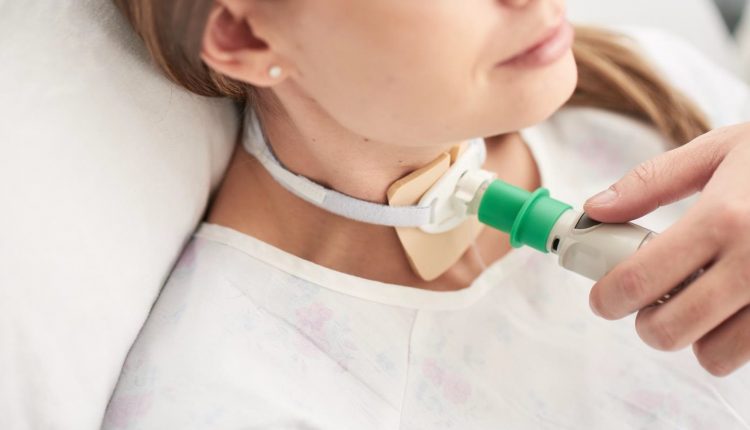
What is laryngectomy? An overview
Laryngectomy is a surgical procedure that consists of the removal of the larynx or part of it. The purpose of the operation is to treat malignant tumour diseases of the larynx
Laryngectomy: depending on the portion of the larynx removed, we distinguish
- supraglottic laryngectomy (horizontal supraglottic laryngectomy): involves the removal of the entire supraglottic larynx up to the bottom of the ventricle and is performed for neoplasms involving the false vocal cords, the laryngeal face of the epiglottis, the hyo-thyro-epiglottic space or the ariepiglottic folds
- subtotal reconstructive laryngectomies: involve the removal of portions of the larynx with reconstruction by pessation (anchorage) to approximate between the cricoid and the hyoid bone or between the cricoid, hyoid bone and supra-hyoid portion of the epiglottis (crico-ioid-pessy or crico-ioid-epiglottis-pessy)
- total laryngectomy: consists of the removal of the larynx in its entirety, including the first tracheal rings and, if necessary, extended to adjacent structures such as the hypopharynx or the base of the tongue.
How is laryngectomy performed?
The operation is performed by an otorhinolaryngologist (specialist head and neck surgeon) and takes place under general anaesthesia.
Access is through an incision in the skin of the neck, through which the larynx or part of it is removed together with lymph nodes (laterocervical emptying) and/or other neck structures (muscles, vessels and nerves).
Partial laryngectomies (supraglottic and subtotal reconstructive) require a temporary opening of the trachea at skin level (tracheotomy) and have the advantage, thanks to the preservation of the crico-arytenoid units (one or, more rarely, both), of allowing phonation and feeding to be restored by natural means.
Total laryngectomy, on the other hand, involves a definitive separation of the airway from the digestive tract and therefore involves the creation of a permanent opening of the trachea at skin level (tracheostoma).
In rare cases, the transposition of a laryngeal flap (usually a pectoralis muscle flap) may be necessary to better reconstruct the surgical defect.
Once the pathological tissue has been removed, it is sent to Pathological Anatomy to obtain a definitive histological diagnosis.
The duration of the operation is variable and depends on the type of operation proposed and the surgical difficulties encountered intraoperatively. Similarly, the length of hospital stay and any additional post-surgical treatment are also highly variable.
How is the post-operative course?
The hospital stay lasts on average 15-20 days.
Feeding is initially by means of a nasogastric tube, which will then be removed by the ward doctor, after swallowing tests (FEES, fiberoptic endoscopic evaluation of swallowing) have been carried out.
The FEES consists of the administration under endoscopic control of food of different consistencies (liquid, semi-liquid, semi-solid, solid), the transit of which is observed during the swallowing act, so as to assess the presence of any stagnation or the possible presence of false pathways. In selected cases, it may be necessary to perform a percutaneous gastrostomy (PEG) to ensure that the patient receives adequate nutrition.
During the hospital stay, the patient will be instructed by the nursing staff on how to clean and manage the tracheal cannula.
The latter is usually removed prior to discharge in patients undergoing partial laryngectomies, while it is kept in place well beyond the date of discharge (months) in those undergoing total laryngectomy, in order to avoid scarring of the tracheostoma.
The removal of part of the larynx inevitably leads to an initial difficulty on the part of the patient both in phonation (voice may change) and in feeding (the protective function of the larynx is partly lost).
This entails the risk that a more or less conspicuous part of the swallowed food and liquids may be diverted into the respiratory tract with consequent coughing and with the risk of developing bronchitis or aspiration bronchopneumonia.
In the post-operative period, therefore, it is necessary to begin functional rehabilitation aimed at the resumption of swallowing and verbal expression.
Once the ability to feed by mouth has been restored, the patient who has undergone reconstructive laryngectomy can be discharged with an indication to go on a soft diet.
The complete removal of the larynx, on the other hand, requires a definitive tracheostoma, through which the inhaled air reaches the lungs directly, without first being filtered, heated and humidified.
It is therefore necessary to filter the air with gauze or special filters. In addition, it is essential to prevent water from entering the tracheostoma, which is why the patient can no longer immerse himself in water and must also be careful when showering.
While the separation of the airways from the digestive tract allows swallowing without the risk of inhalation, it also leads to initial difficulty in verbal expression.
Voice recovery after total laryngectomy can be carried out in different ways:
- oesophageal (or erygmophonic) voice: air stored in the oesophagus is eructated leading to the vibration of the upper oesophageal sphincter and overlying structures, resulting in verbal articulation;
- phonatory valve: after a communication is established between the trachea and oesophagus (tracheo-oesophageal fistula) a valve is placed which, when closed with a finger, allows expired air to pass to the overlying structures (thus allowing verbal articulation), but prevents the reflux of saliva and food from the oesophagus to the lower airways;
- laryngophone (now disused): the application of the instrument in the suprahyoid region produces a vibration that simulates that of the vocal cords and is transmitted through the tissues of the oral floor, thus allowing verbal expression.
Read Also:
Emergency Live Even More…Live: Download The New Free App Of Your Newspaper For IOS And Android
Rare Diseases: Bardet Biedl Syndrome
Rare Diseases: Positive Results Of A Phase 3 Study For The Treatment Of Idiopathic Hypersomnia
Fetal Surgery, Surgery On Laryngeal Atresia At Gaslini: The Second In The World
Own The Airway Part 4: Laryngoscopy



